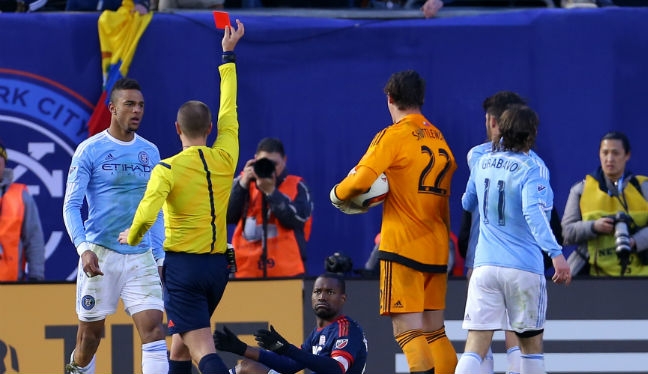Play of the Week 2: DOGSO in NYC v NE and CLB v TOR

By PRO Training & Development Manager Paul Rejer
This week’s Play of the Week discusses two DOGSO (Denial of an Obvious Goalscoring Opportunity) situations: on Saturday in the Columbus Crew versus Toronto FC game and on Sunday in New York City versus New England Revolution.
I would also like to point out how important angles are when examining incidents and how easy it can be to jump to the wrong conclusion. Finally, I have a lesson in keeping focussed as a referee, and as an AR or 4th Official, ensuring you supply the center referee with the correct information.
The criteria laid down in the Laws of the Game are as follows:
Referees should consider the following circumstances when deciding whether to send off a player for denying a goal or an
obvious goalscoring opportunity:
– The distance between the offense and the goal
– The likelihood of keeping or gaining control of the ball
– The direction of the play
– The location and number of offenders
– The offense which denies an opponent an obvious goalscoring opportunity may be an offense that incurs a direct free kick or an indirect free kick
First, let’s look at the New York City incident.
It is clear that, from the long ball by goalkeeper Josh Saunders, City’s Khiry Shelton is moving towards goal. He has control of the ball, he is advancing towards the penalty area and the closest defender, Andrew Farrell, is trailing behind when Shelton is fouled by Jose Goncalves. Also, it is an offense that incurs a free kick. Therefore, this meets all the criteria laid down in law and the referee Mark Geiger was correct to issue the red card to Goncalves.
In th
e Columbus Crew versus Toronto FC game, Crew’s Ethan Finlay is the player moving goalwards with the likelihood of keeping control of the ball and advancing towards the penalty area, thus fulfilling the requirement of ‘distance between the offense and the goal’.
When Toronto’s Justin Morrow is penalized for a foul on Finlay, the closest defender is Damien Perquis, who is trailing. The only element of doubt initially in a lot of people’s minds when viewing this incident was whether or not it was actually a foul challenge, as the replays seem to suggest that Morrow won the ball cleanly and made no contact with Ethan Finlay.
However, when we see this play from an alternative angle (see below), it is clear that it was a foul and the final criteria is satisfied with this being an offense that incurs a free kick. Therefore, this also meets the requirements laid down in law and referee Dave Gantar was correct to send off Justin Morrow.
Unfortunately, the referee initially showed the red card to the wrong player, Damien Perquis, after consulting with AR Danny Thornberry, but this was quickly rectified. This is a lesson to all aspiring referees in keeping focussed and never losing sight of an offending player, and to ARs and 4th Officials that they also have a responsibility to assist the referee and ensure he is given the correct information.
